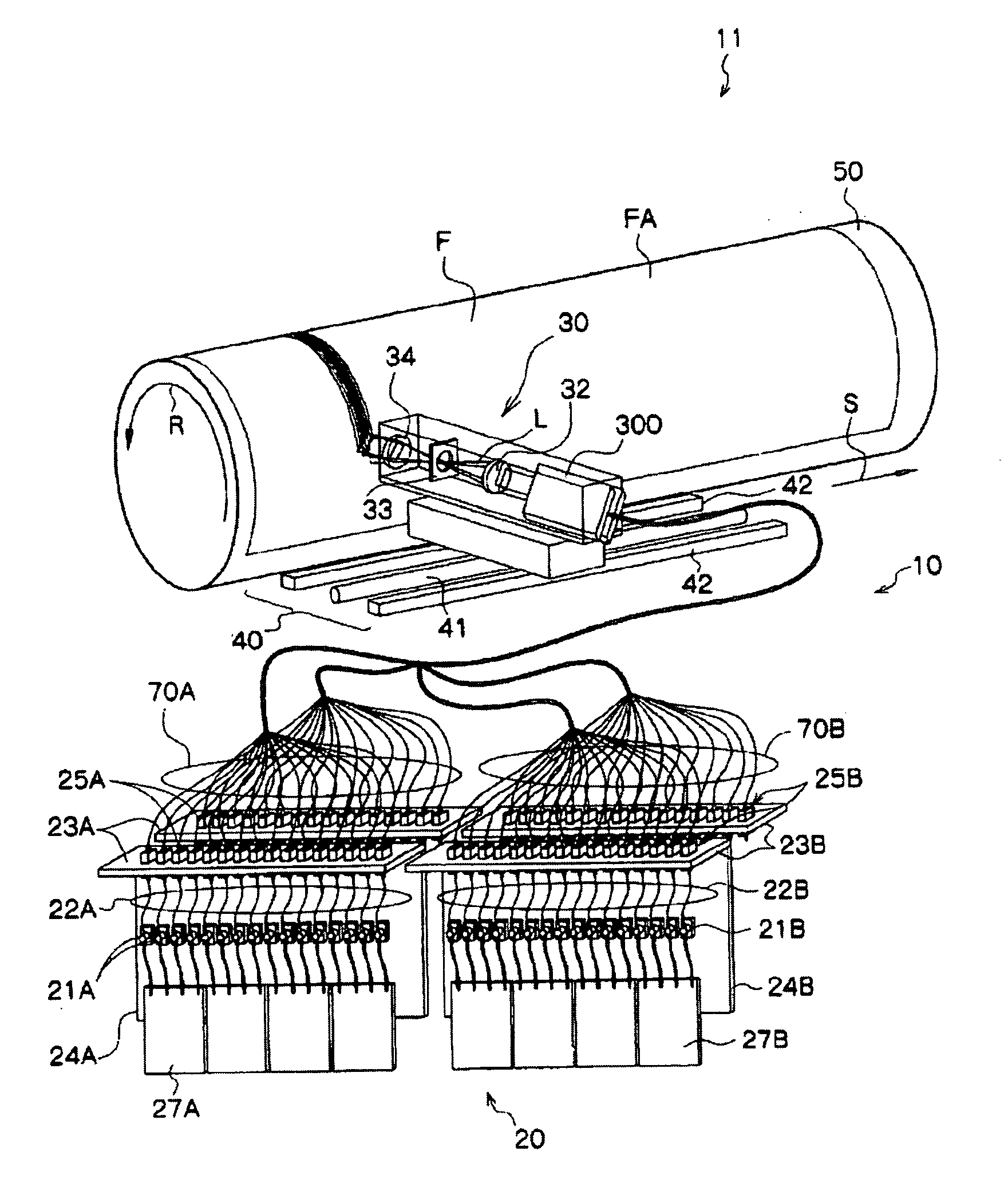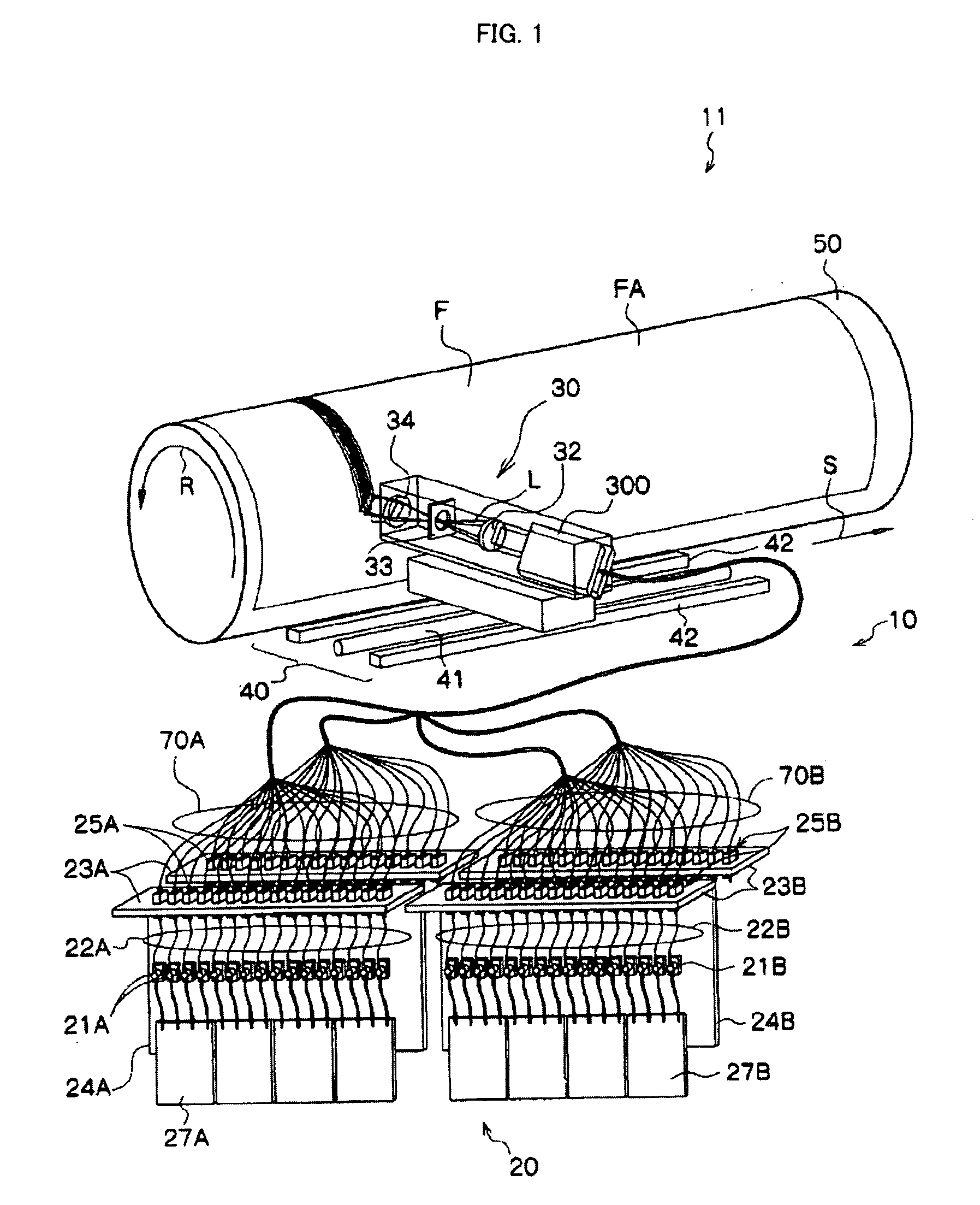Method of manufacturing relief printing plate and printing plate precursor for laser engraving
a printing plate and laser engraving technology, applied in the field of manufacturing relief printing plates and printing plate precursors for laser engraving, can solve the problems of low productivity of the method, slow laser engraving speed, and time-consuming plate making process for the production of original image films, etc., and achieve high output, high output, and high output
- Summary
- Abstract
- Description
- Claims
- Application Information
AI Technical Summary
Benefits of technology
Problems solved by technology
Method used
Image
Examples
synthetic example 1
Synthesis of Polyurethane resin P-1
[0374]8.2 g (0.05 mol) of 2,2-Bis(hydroxymethyl)butanoic acid and 13.0 g (0.05 mol) of the following diol compound (1) were dissolved in 100 ml of N,N-dimethylacetamide in a 500-ml three-necked round bottom flask equipped with a condenser and a stirrer. 25.5 g (0.102 mol) of 4,4-diphenylmethane diisocyanate and 0.1 g of dibutyl tin dilaurylate were added to the resultant, followed by heating at 100° C. for 8 hours with stirring. After that, the resultant was diluted with 100 ml of N,N-dimethylformamide and 200 ml of methyl alcohol followed by stirring for 30 minutes. The reaction solution was poured into 3 liters of water with stirring so that a white polymer was precipitated. The polymer was taken by filteration, washed with water and dried under vaccum to give 37 g of polymer.
[0375]A molecular weight of the polymer was measured by means of gel permeation chromatography (GPC) and turned out to be 95,000 in terms of the weight-average molecular wei...
example 9
[0400]50 parts by weight of polyvinyl butyral (trade name: #3000-1, manufactured by Denki Kagaku Kogyo) as a binder polymer, 20 parts by weight of diethylene glycol as a plasticizer and 30 parts by weight of ethanol as a solvent were placed in a three-necked flask equipped with a stirring spatula and a cooling pipe and heated at 70° C. for 120 minutes to dissolve the binder polymer.
[0401]15 parts by weight of an ethylenic unsaturated monomer (trade name: LIGHT ACRYLATE 14EG-A, diacrylate of polyethylene glycol 600, manufactured by Kyoeisha Kagaku), 15 parts by weight of polyalkylene glycol(meth)acrylate monomer (trade name: BLEMMER PE-200, manufactured by NOF), 1.5 parts by weight of tert-butyl peroxide (trade name: PERBUTYL Z, manufactured by NOF) as a polymerization initiator and 0.005 part by weight of ammonium N-nitrosophenyl hydroxylamine (trade name: Q-1300, manufactured by Wako Pure Chemical Industries), 3 parts by weight of ZnCl2 (manufactured by Wako Pure Chemical Industrie...
example 10
[0403]50 parts by weight of styrene-butadiene polymer (trade name: NIPOL NS 116R, manufactured by Nippon Zeon) as a binder polymer, 0.7 part by weight of carbon black (SEAST 9H SAF-HS, manufactured by Tokai Carbon) and 30 parts by weight of methyl ethyl ketone were placed in a three-necked flask equipped with a stirring spatula and a cooling pipe and stirred for 30 minutes to give an application solution composition for forming a relief forming layer having fluidity. This application solution composition for forming a relief forming layer for Example 10 was flown on the surface of the second adhesive layer side of the support which was the same as that used in Example 1 and dried for 1 hour in an oven set at 100° C. to form a layered body having a non-crosslinked relief forming layer having a thickness of about 1,100 μm, which includes a thickness of the support, so that a printing plate precursor 10 for relief printing plate for laser engraving was prepared.
PUM
 Login to View More
Login to View More Abstract
Description
Claims
Application Information
 Login to View More
Login to View More - R&D
- Intellectual Property
- Life Sciences
- Materials
- Tech Scout
- Unparalleled Data Quality
- Higher Quality Content
- 60% Fewer Hallucinations
Browse by: Latest US Patents, China's latest patents, Technical Efficacy Thesaurus, Application Domain, Technology Topic, Popular Technical Reports.
© 2025 PatSnap. All rights reserved.Legal|Privacy policy|Modern Slavery Act Transparency Statement|Sitemap|About US| Contact US: help@patsnap.com



